The National Archaeological Museum in Naples, Museo Archeologico Nazionale di Napoli in Italian, often abbreviated to MANN, is one of the most important museums in Naples, if not the world, because of its large collection of Roman mosaics and frescoes from the excavations of Herculaneum and Pompeii and its Egyptian collection. The building is so large that it is impossible to see the whole exhibition in one go. In this article, I give you the main information on what to see and how best to organise your visit.
Table of Contents
What’s inside the National Archaeological Museum in Naples
The MANN is most famous for its exhibition of finds from the archaeological sites of Pompeii and Herculaneum, but it also houses Etruscan, Egyptian, Greek and Roman artefacts. The Egyptian collection is the second most important in Italy and the third in the world, after the National Museum of Egyptian Civilisation in Cairo and the Egyptian Museum in Turin.
ORGANISE YOUR TRIP TO NAPLES
Get the Naples Pass to save money. The card gives you access to attractions like the underground city tour and the Catacombs of San Gennaro, and unlimited public transport during its validity.
To stay connected in Italy, remember to buy an Airalo eSim online, with data and phone coverage for your trip to Naples.
The building housing the MANN is located in the centre, inside the Palazzo degli Studi, one of Naples’ monumental palaces. Built in 1585 to become a cavalry barracks, turned for a while into an astronomical observatory. Now the building houses the Archaeological Museum, a library, the restoration laboratory and the historical archives.
The façade is easily recognisable because it is painted entirely in the classic Pompeian red colour. The exhibition area open to the public covers more than 8,000 square metres. This space is mostly dedicated to permanent collections and temporary exhibitions. Plus offices, services and storage.
The permanent exhibition is divided into different sections by type of collection. The permanent exhibition is divided into different sections based on the type of collection. To help you navigate, the Farnese Collection consists of statues that were initially acquired by Pope Alexander Farnese and later expanded by the Bourbons. The Pompeian Collections, on the other hand, contain all archaeological finds from Pompeii and Herculaneum that were part of the Bourbon collections. Lastly, the Egyptian Collection features funerary objects and sculptures of pharaohs.
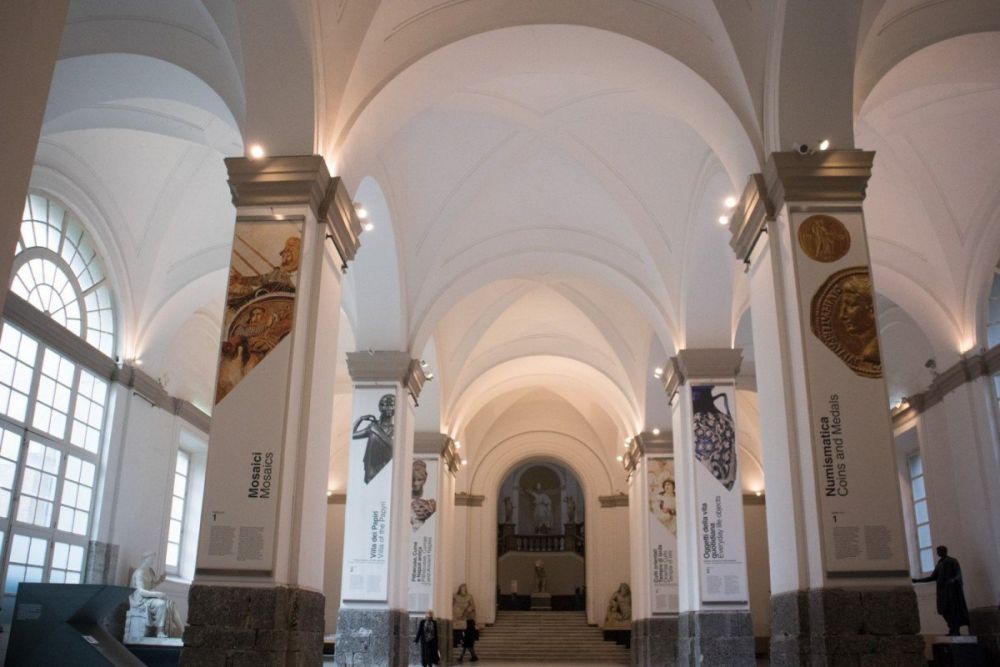
Statuary from the Farnese Collection
The initial section of the National Archaeological Museum of Naples’ tour showcases the Farnese Collection’s statues. The collection’s establishment dates back to 1534 and was initiated by Alessandro Farnese, who later became Pope Paul III. Within the MANN’s atrium and dedicated gallery, you can admire grand marble and bronze statues of Roman emperors and empresses.
The collection of antiquities at the Naples National Archaeological Museum has an interesting history. It was initially founded with artifacts discovered during the excavation of the Baths of Caracalla in Rome. Over time, the collection grew in size thanks to the efforts of the Farnese family, who acquired additional pieces through market research, requisitions, and archaeological excavations. Ultimately, the collection was inherited by King Charles III of Bourbon, who moved it from Rome to Naples. Charles III was King of Naples from 1734 to 1759 and received the collection from his mother, Elisabeth, who was the wife of Philip V of Spain and the last descendant of the Farnese family.
The National Archaeological Museum in Naples has arranged its statues in a way that reflects the original display in the Farnese family residences. The groups of statues are organized according to specific themes and interests. Such as philosophers and illustrious men, or by discovery, such as the group from the Baths of Caracalla. This arrangement allows visitors to appreciate the historical context of the statues and appreciate their significance.
The Pompeian Collection
The collection from the archaeological excavations in Pompeii and Herculaneum contains mosaics, frescoes, and sculptures, all discovered during the Vesuvian excavations. The most significant part of the collection, the mosaics, were uncovered during the archaeological excavations conducted by Joachim Murat in the 19th century. The artifacts discovered in Herculaneum, on the other hand, date back to the excavations carried out later by King Charles of Bourbon in the 18th century.
There are many items in the Pompeian Collection. Such as common objects from the Vesuvian region, as well as mosaics and frescoes. I highly recommend visiting the museum before going to the archaeological sites of Herculaneum and Pompeii. This will allow you to arrive prepared about the art and styles of the period.
Pompeii mosaics
The National Archaeological Museum of Naples houses the Pompeian Collection, which mainly consists of mosaics. Among them, a significant portion is derived from the House of the Faun in Pompeii, named after the bronze statue of a dancing faun discovered inside the house.
The Pompeian mosaics are made of tiny tesserae and resemble digital pixel-art images. The mosaic tesserae manage to perfectly render every tiny nuance and shading. Their beauty is truly impressive even after almost two thousand years.
The exhibition features various kitchen and banquet mosaics. This showcases striking similarities between the interests of the ancient Romans and our own. These mosaics depict scenes such as chickens pecking before being cooked, fish waiting to be sautéed, and extravagant feasts. There are several noteworthy mosaics at the site, including a memento mori skull with ears, and a massive mosaic depicting the Battle of Issus between Alexander the Great and Persian king Darius III.
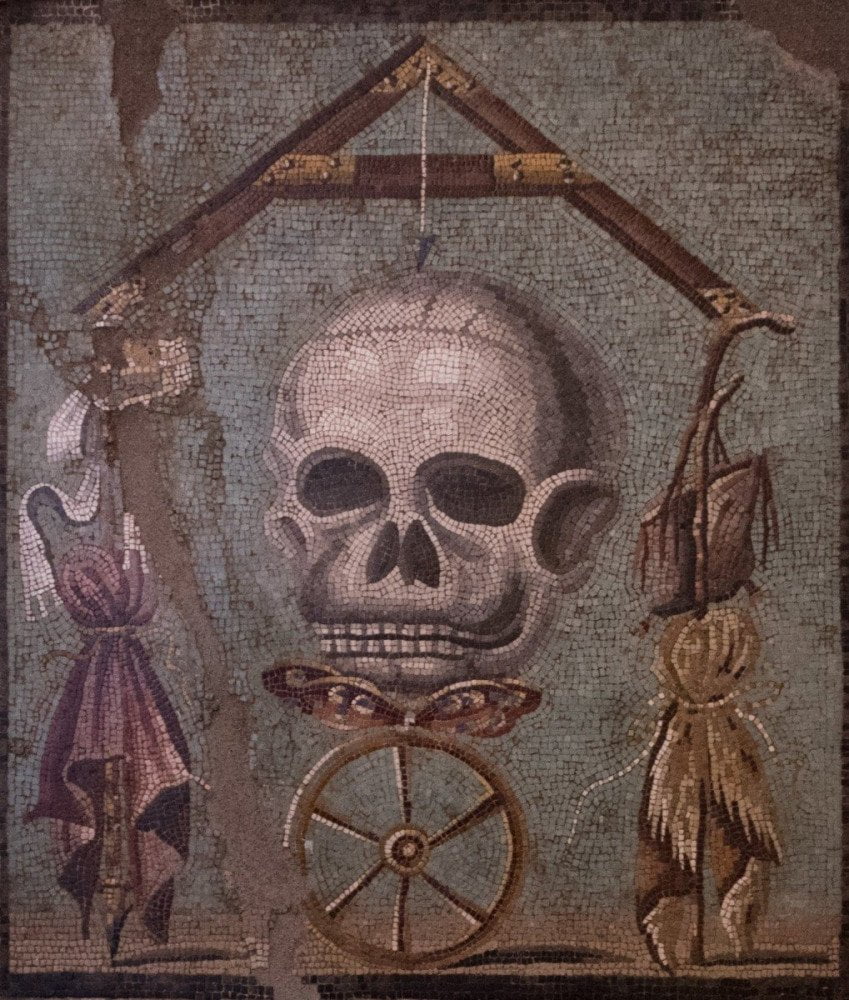
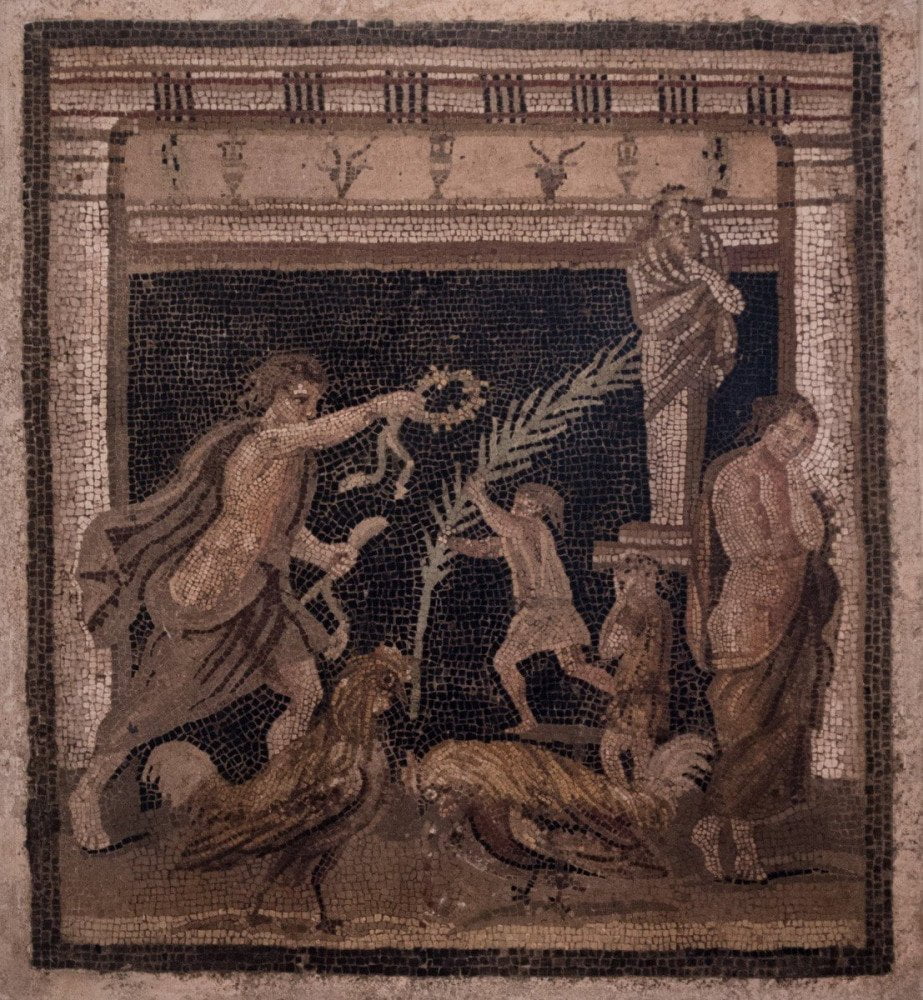
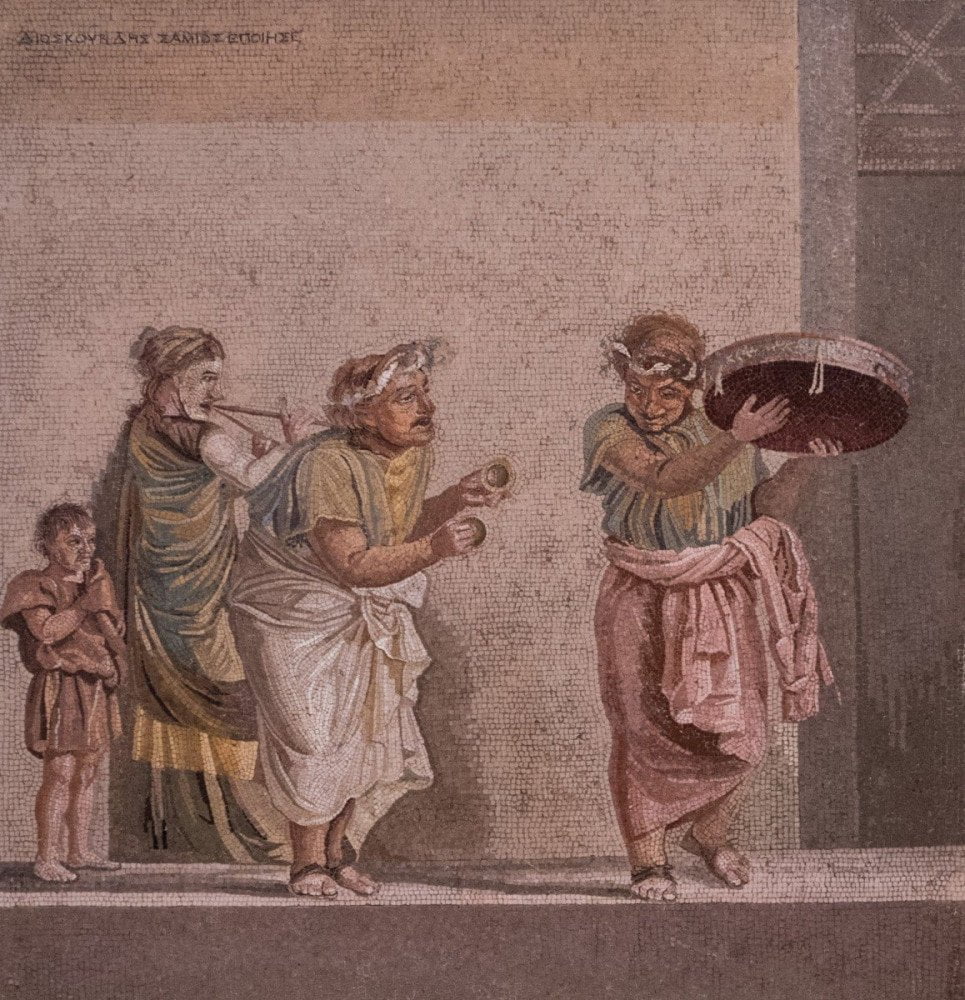
The Temple of Isis in Pompeii
During my visit to the Archaeological Museum in Naples, I learned about the strong connection between the Roman and Egyptian civilisations. One notable example is the temple dedicated to the Egyptian goddess Isis during the archaeological excavations of Pompeii.
The Temple of Isis was a significant religious building of its time. It was decorated with various artworks such as statues of Egyptian gods, paintings of dragons, lions, sphinxes, dolphins, still lives, Egyptian landscapes, and naval battles. If you find these exhibits intriguing, you can compare them with the style of the exhibits in the Egyptian Collection.
Model of Pompeii
The National Archaeological Museum located in Naples has a stunning 1:100 scale model of Pompeii. The model accurately depicts the city’s appearance from the beginning of the excavations to the end of World War II. The model itself is a masterpiece, created in the early 20th century by Felice Padiglione and Nicola Roncicchi. They were also responsible for making the model of Villa della Pisanella in Boscoreale.
Anyway, the model of Pompeii was initiated by Giuseppe Fiorelli, inspector of the excavations in Pompeii and curator of the Museum since the end of the 19th century. Today its importance is not only on an artistic level, but also for the study of Pompeii. The model in fact also shows the decorations of buildings that were subsequently damaged by war or earthquakes.
The Egyptian Collection
The National Archaeological Museum in Naples houses one of the largest Egyptian collections in the world, after the National Museum of Egyptian Civilisation in Cairo and the Egyptian Museum in Turin. The exhibits in the Egyptian Collection come both from the acquisition of the private collections of the Borgia, Drosso-Picchianti, Hogg and Schnars families, and from Bourbon excavations in the Vesuvian and Phlegraean areas.
The MANN’s permanent exhibition on Egyptian civilisation offers a comprehensive overview of life in Ancient Egypt. The exhibition is divided into thematic sections on Egyptian civilisation. It includes the cult of the dead, and the role of the pharaohs and Egyptian government officials, including the military, scribes and priests.
The Sundial Hall
The Archaeological Museum of Naples hosts temporary exhibitions in the Gran Salone della Meridiana, in English the Sundial Room. This large space was created in the early 17th century by modifying the building of the Royal Stables. The Sundial Hall is incredibly spacious, and its vault is entirely frescoed. On the walls, there are eighteen large canvases that depict Alessandro Farnese’s exploits in Flanders.
The sundial line
The room is named after the sundial line that was designed by Pompeo Schiantarelli. If you look down, you can see a brass strip embedded between the marble slabs of the floor. The strip is embellished with medallions that have painted signs of the zodiac.
The floor sundial works with the light that comes from above the dome, and it runs along the line at noon, stopping on the corresponding season. Curiously, the hall and sundial were built to turn MANN into an observatory, but the unsuitable site led to the project’s abandonment.
It is not possible to carry out astronomical observations from the site of the present National Archaeological Museum of Naples due to the clutter of other buildings. This is because all observatories in the world are located in isolated areas that are elevated above the nearest cities.
The Farnese Atlas Statue
The magnificent statue of Atlas Farnese is on display in the Sala della Meridiana of the Archaeological Museum of Naples. The statue is made of marble and belongs to the Farnese collection. It represents the titan Atlas kneeling under the weight of the terrestrial globe. The sphere on which he kneels depicts the celestial vault, meridians, and zodiac.
During my visit, I noticed that the Atlas Farnese statue was surrounded by mirrors. This made it even more impressive and allowed me to admire it in great detail. I am unsure whether this was a permanent installation or done specifically for the Thalassa exhibition showcasing underwater wonders of the Mediterranean at that time.
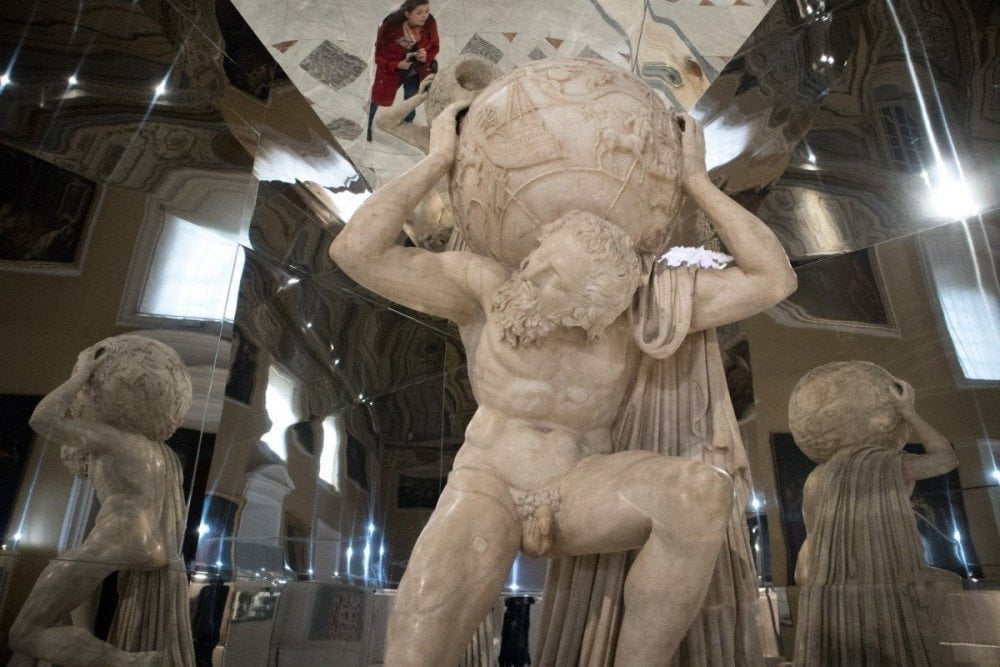
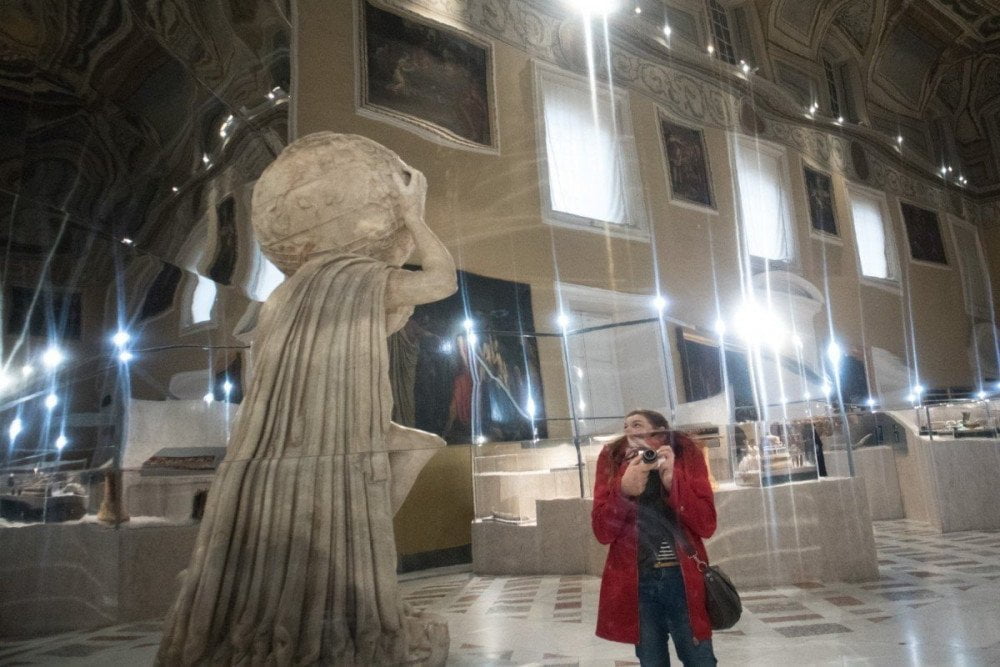
Temporary exhibitions at the National Archaeological Museum in Naples
The National Archaeological Museum in Naples regularly hosts temporary exhibitions in the Gran Salone della Meridiana. During my visit, the splendid exhibition Thalassa on the relationship between the ancient Romans and the sea was on display. Thanks to this exhibition, I discovered the existence of underwater archaeology and many little-known underwater wonders of the Mediterranean.
The MANN museum frequently updates its calendar of exhibitions and events, which include topics of archaeology beyond the museum’s collections. Thanks to loans from other structures, you can visit the museum and enjoy temporary exhibitions like the one dedicated to Byzantine civilization. Additionally, exhibits that are kept in storage are displayed temporarily during other times.
Practical info for visiting the National Archaeological Museum of Naples
The National Archaeological Museum in Naples is one of the largest museums I have ever visited. To see the entire permanent collection, or at least the parts that interest you the most, requires some planning and organisation. The permanent exhibition is vast. Especially if you would like to visit the most popular sections, such as the Pompeian mosaics, the statuary from the Farnese Collection, and the section dedicated to the Egyptian civilization.
The area of the Archaeological Museum that is accessible to visitors includes two historic gardens situated in the inner courtyards, as well as a bookshop, a cafeteria, and a cloakroom. It is mandatory to deposit suitcases, backpacks, and bulky bags in the cloakroom before entering the museum. However, as per the museum regulations, you cannot leave your jacket behind.
How long to dedicate to your visit
To visit the main collections on display at the National Archaeological Museum of Naples consider at least half a day. Although this is barely enough time to go through all the rooms. However, for an in-depth visit to the themes that interest you most, I suggest devoting a whole day.
You can explore all the rooms independently in the morning. Afterwards, you can have lunch at the museum cafeteria and continue your visit in the afternoon. If you want to make the most of your visit, I recommend adding a guided tour of National Archaeological Museum of Naples. In my opinion, it’s the best way to appreciate the museum.
MANN tickets price
Tickets for the National Archaeological Museum of Naples start at €18 per adult. MANN tickets are more expensive than in other Neapolitan museums, but they are definitely worth the expense. If you are interested in learning about Ancient Rome or Egypt, this museum will amaze you with its impressive collection on display.
Unfortunately, now the MANN museum is no longer included in the Naples Pass. However, you can still visit the museum and keep your ticket to avail a discount on the activities and other museums that are part of the ExtraMann circuit. Keep an eye out for any updates and changes in the future.
Children and young people up to 18 years of age get in free. Reductions are available for children aged between 18 and 25 who are citizens of the European Union.
Opening hours of the Archaeological Museum of Naples
The opening hours of the National Archaeological Museum of Naples are quite unusual, with some collections open on a rotating basis. I suggest you plan your visit according to the opening times of the sections. This way you can be sure that the collection you are interested in is actually open to the public during your visit to the museum.
In general, the National Archaeological Museum of Naples is open every day except Tuesdays from 9:00 to 19:30. Last admission is at 18:30. At the time of writing the Egyptian Collection is temporarily closed, but is usually open in the morning.
Admission to the museum may be limited in case of a large turnout. For this reason, I recommend that you buy your ticket online in advance. So you won’t queue at the ticket office. Below you can see a constantly updated interactive calendar with opening dates and ticket availability. Click on the date you are interested in to check ticket availability.
How to get to the Archaeological Museum of Naples
The National Archaeological Museum of Naples is located in the centre of Naples and is easily accessible on foot or by public transport. If you travel by metro, the nearest stops are Museo on line 1 and Cavour on line 2. Several buses also pass near the museum, including bus 201, bus R1. The Naples city sightseeing bus has a dedicated stop for those wishing to visit the MANN.
MANN – Museo Archeologico Nazionale di Napoli
Piazza Museo, 19
80135 Napoli
Where to stay in Naples
Naples boasts numerous accommodations, from hotels to seaside flats. With my frequent visits to Naples, I can suggest several options. For an authentic experience in the historic center, consider The Idyll Boutique Apartment in the Spanish Quarter. This charming flat features parquet floors and a fully equipped kitchen, conveniently close to major attractions. Alternatively, the upscale Relais Della Porta, situated on Via Toledo, places you a short distance from landmarks like the San Carlo Theatre. Last but not least, the Santa Chiara Boutique Hotel, located near the Dante metro stop, offers a continental or Italian breakfast to start your day.
The National Archaeological Museum in Naples is really one of the biggest museums I have visited. It contains some truly incredible archaeological artefacts such as the mosaics of the House of the Faun and the statues of the Farnese Collection that amazed me with their beauty. The building that houses the museum itself is splendid, with its historical gardens and the sundial on the floor. My advice is to absolutely visit it!
Write to me in the comments if you already know the National Archaeological Museum of Naples or if this article has convinced you to include it in the museums to see during a visit to the Neapolitan capital.
